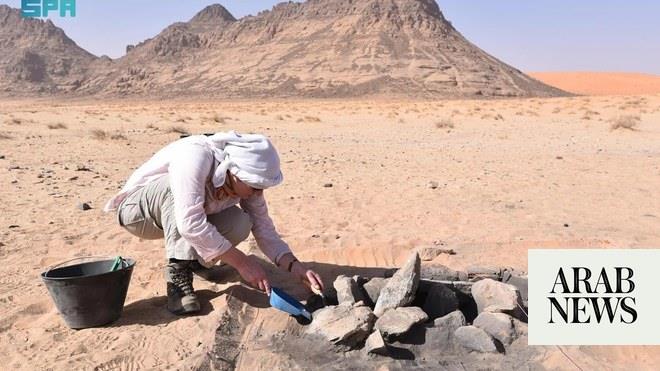
RIYADH: Stone tools dating back 200,000 years to the Paleolithic period have been unearthed in Shuaib Al-Adgham in the eastern Qassim region by a Saudi Arabian scientific team.
The tools include large numbers of stone axes “made with high precision,” the Kingdom’s Heritage Authority said.
The site, one of the most important yet found in Saudi Arabia, dates back to the middle Paleolithic age and even further to the so-called Acheulean civilization, estimated to be at least 200,000 years old.
The Acheulean civilization is characterized by the development of stone tools and axes, one of the most important implements of the age.
The abundance of stone tools unearthed at the site reflects the large number of prehistoric humans that lived in the region. It is also a clear indication that climatic conditions in the Arabian Peninsula were highly suitable for these human groups, which benefited from the region’s natural resources.
According to the authority, the stone tools are also evidence of the existence of human societies in Arabia going back hundreds of thousands of years.
Satellite footage showed that the Acheulean sites, including Shuaib Al-Adgham, were located near rivers, which were used by Stone Age people to access the deep interior of Arabia.
Sites around ancient valleys and rivers show that human groups gradually spread and discovered new inhabitable areas. The sites are characterized by an abundance of stone fragments and manufacturing tools.
Surveys concluded that there might be thousands of similar tools buried at the site.FASTFACT
The tools include large numbers of stone axes ‘made with high precision.’
The authority said that environmental and cultural information gathered at the site showed that conditions in the past have ranged from extremely arid to humid.
Evidence strongly supports the claim that there was a “green Arabia” at several times in the past, the authority said.
Rivers and lakes throughout Arabia led to the expansion of human groups, proving that Arabia was an intersection of major routes between Africa and Asia throughout prehistory and a region of settlement during the Paleolithic age.
Ancient immigrations occurred via two major pathways, Bab Al-Mandab and Sinai.
The authority said that its scientific teams will carry out further research at the site, revealing new evidence that proves Arabia was one of the most important places for human settlement during the Stone Age.
Based on its location in the middle of Arabia, Qassim is rich in archaeological sites with evidence of historical civilizations in the region.
These include inscriptions and rock drawings that were previously discovered and recorded in the national archaeological register at the Heritage Authority.












